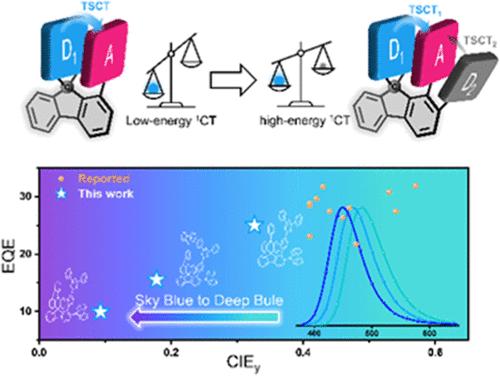Competitive Spatial Donor/Acceptor Interaction toward Efficient Blue Thermally Activated Delayed Fluorescence
IF 8.2
2区 材料科学
Q1 MATERIALS SCIENCE, MULTIDISCIPLINARY
引用次数: 0
Abstract
Through-space charge-transfer (TSCT) thermally activated delayed fluorescence (TADF) emitters show great promise for blue organic light-emitting diodes (OLEDs) but face challenges such as low efficiency and limited color purity. In this study, we designed and synthesized three asymmetric TSCT-TADF materials─CzTPT-PA, CzTPT-CIA, and CzTPT-IA─based on a dual donor/acceptor (D1/A/D2) architecture. The molecular design strategically leverages dominant donor–acceptor interactions and auxiliary coupling effects within a unique sandwich-like π-stacked structure, enabling precise control over excited-state properties. This design achieves blue-shifted emission while maintaining high photoluminescence quantum yields, addressing efficiency loss and concentration quenching through spatially confined interactions and locked molecular conformations. The resulting OLEDs exhibited blue electroluminescence with color coordinates of (0.16, 0.27), (0.15, 0.18), and (0.15, 0.09) for CzTPT-PA, CzTPT-CIA, and CzTPT-IA, respectively, alongside maximum external quantum efficiencies of 25.0%, 15.5%, and 9.9%. Notably, the CzTPT-IA-based device achieved deep-blue emission with high color purity, representing a significant advancement in the field. This work introduces an effective design strategy for TSCT-TADF emitters, paving the way for high-performance, blue OLEDs with enhanced efficiency and color precision.

竞争空间供体/受体相互作用对有效的蓝色热激活延迟荧光
通过空间电荷转移(TSCT)热激活延迟荧光(TADF)发射器显示了蓝色有机发光二极管(oled)的巨大前景,但面临着诸如低效率和有限的颜色纯度等挑战。在这项研究中,我们设计并合成了三种基于双供体/受体(D1/ a /D2)结构的不对称TSCT-TADF材料:CzTPT-PA、CzTPT-CIA和CzTPT-IA。该分子设计策略性地利用了在独特的三明治状π堆叠结构中占主导地位的供体-受体相互作用和辅助耦合效应,从而能够精确控制激发态性质。该设计在保持高光致发光量子产率的同时实现了蓝移发射,通过空间受限的相互作用和锁定的分子构象解决了效率损失和浓度猝灭问题。所制得的CzTPT-PA、CzTPT-CIA和CzTPT-IA的电致发光颜色坐标分别为(0.16,0.27)、(0.15,0.18)和(0.15,0.09),最大外量子效率分别为25.0%、15.5%和9.9%。值得注意的是,基于cztpt - ia的器件实现了具有高颜色纯度的深蓝色发射,代表了该领域的重大进步。这项工作介绍了一种有效的TSCT-TADF发射器设计策略,为高性能蓝色oled铺平了道路,提高了效率和色彩精度。
本文章由计算机程序翻译,如有差异,请以英文原文为准。
求助全文
约1分钟内获得全文
求助全文
来源期刊

ACS Applied Materials & Interfaces
工程技术-材料科学:综合
CiteScore
16.00
自引率
6.30%
发文量
4978
审稿时长
1.8 months
期刊介绍:
ACS Applied Materials & Interfaces is a leading interdisciplinary journal that brings together chemists, engineers, physicists, and biologists to explore the development and utilization of newly-discovered materials and interfacial processes for specific applications. Our journal has experienced remarkable growth since its establishment in 2009, both in terms of the number of articles published and the impact of the research showcased. We are proud to foster a truly global community, with the majority of published articles originating from outside the United States, reflecting the rapid growth of applied research worldwide.
 求助内容:
求助内容: 应助结果提醒方式:
应助结果提醒方式:


